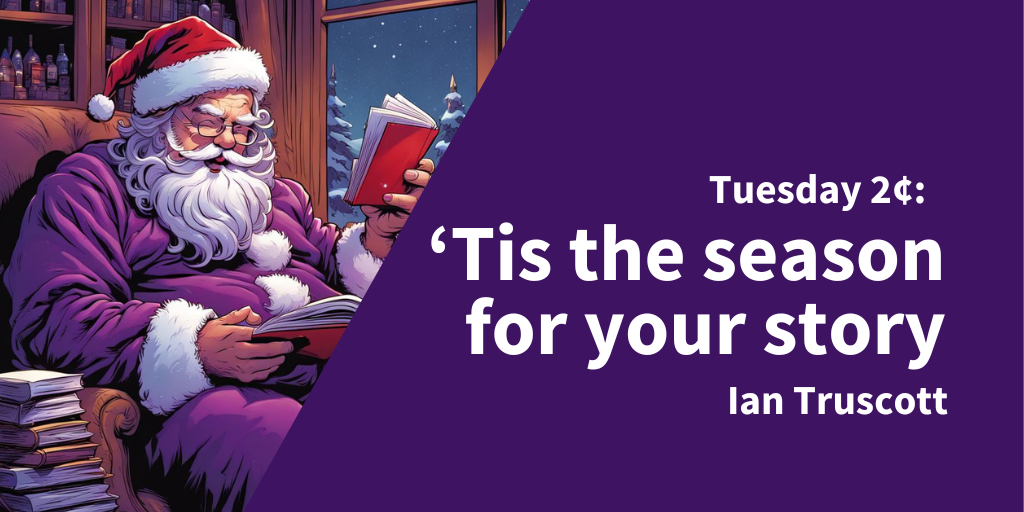This week, I am right up with the zeitgeist and the cool kids, as this post is inspired by a 200-year-old holiday poem.
‘Twas the last Tuesday 2 cents before the holidays when all through the house. Not a creature was stirring, not even a mouse.
That first paragraph was adapted from “A Visit from St. Nicholas”, more commonly known as “The Night Before Christmas”, a 1823 poem that has arguably helped shape the stories of Santa Claus, how we celebrate the holidays, that has continued over the years with its appearance in songs and film.
Commercially, it’s impacted our culture too, as (according to Wikipedia) it has had a massive effect on the history of Christmas gift-giving.
A lot about this time of year revolves around stories, our beliefs, family stories, traditions and the stories we tell ourselves about what makes this time of year special, even whether the story of Die Hard is a Christmas movie. (It is!).
Assuming, of course, you celebrate, if you don’t, you have a different story. ‘Tis the season for stories.
Stories are powerful, and they inspire other stories. The story in this old poem has influenced so much, beyond shopping, but seasonal art, culture, and new stories.
And that’s my point this week, it’s not just that stories are powerful, but what’s powerful is how we tell them, how we interpret them, adapt them and add our own personal experiences and build our own stories.
Everything we pass on as thought leadership, opinion or content marketing is built on top of things we’ve read, experiences we’ve had and what went before. None of what we do as content marketers is original until we add our slant, the sprinkle of our opinion or some anecdote or data that is uniquely ours.
And I can’t be cruising to the close of 2023 without mentioning generative A.I. or “synthetic content”. This is what will differentiate content in 2024, this human bit. This ability to take a story and make it our own.
I’ve spent a lot of time with ChatGPT, and it is jolly good (which is a crushing understatement for this technology), but it can only assemble content from what exists.
I had to be careful there as it’s so easy to say “create content”, but is that what’s really happening? Is it more “assemble” or maybe “synthesize”? Or, as one comment on LinkedIn suggested to me, “plagiarise”.
Anyway, back to my idea for this week, we humans build on stories.
If you read The Night Before Christmas, it mentions Santa, his reindeers and gives plenty of detail on the scene of his visit. But it does not mention the classic image we know today of him wearing red.
Illustrations at the time had him wearing various colors, including red. And you could then argue that Coca-Cola then defined our classic image of Santa in the 1930s through their interpretation of St Nick in their ads featuring this jolly chap wearing red. Since then Santa’s suit is only red (it’s baked into the culture), and a whole new set of stores have been built on that premise.
My point, which I admit is slightly shoehorned into a seasonal story, is that they took the story and added to it, contributing to the holiday culture.
And A.I. could not have done that, as it would only have used the data that went before.
Stories are powerful, and the power will be in how we tell them and the creativity we can uniquely add in a world of AI or not.
‘Tis the season for your story.
Aside from my ongoing argument about my casual writing style and curse words with Grammarly, robots did not write any of this copy, but they did create the image, which was created with NightCafe Studio.
Fancy more of this?
Subscribe to my Rockstar CMO Newsletter

I’m a 3xCMO, now a marketing strategy advisor and podcast host at Rockstar CMO. Although, I’m not a rock star, but a marketing leader, strategist, content marketer, columnist, speaker, industry watcher, and creator of ART (Awareness, Revenue, and Trust) for the companies I work with. But most of all, I am an enthusiastic tea drinker.
You can find me on LinkedIn, Twitter, or now Threads! – or listen to my weekly podcast at Rockstarcmo.com
The half-baked thoughts shared on this blog may not reflect those of my employer or clients, and if the topic of this article is interesting or you just want to say hello please get in touch.
